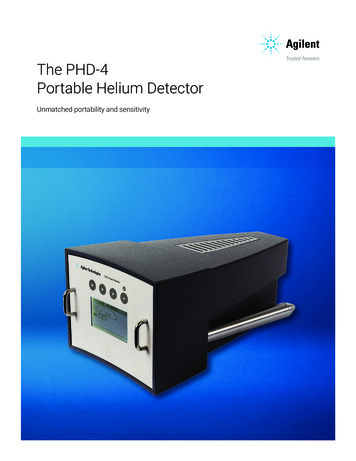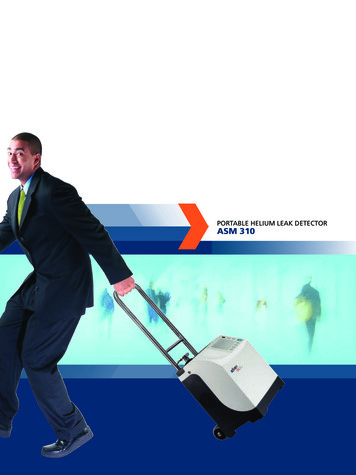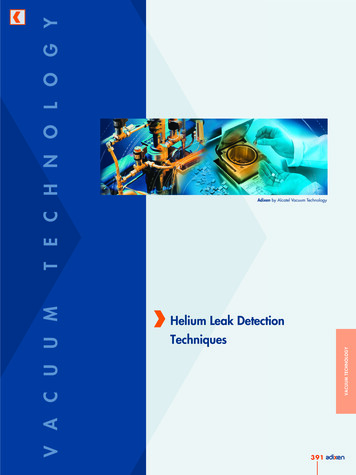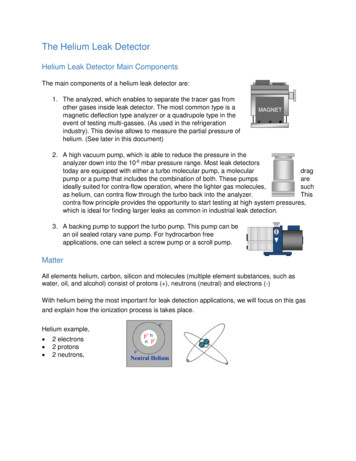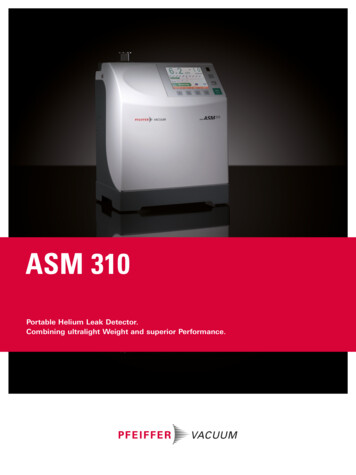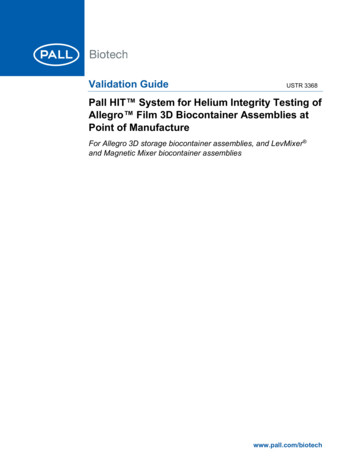
Transcription
Validation GuideUSTR 3368Pall HIT System for Helium Integrity Testing ofAllegro Film 3D Biocontainer Assemblies atPoint of ManufactureFor Allegro 3D storage biocontainer assemblies, and LevMixer and Magnetic Mixer biocontainer assemblieswww.pall.com/biotech
Contents123456Validation Overview . 31.1Introduction . 31.2Summary of Conclusions. 31.2.1HIT System Design Verification . 31.2.2HIT System Operational Qualification . 41.2.3HIT System Performance Qualification . 41.2.4HIT System Transfer Line Qualification . 41.3Background. 51.4HIT Method Principle . 51.5HIT Equipment Description. 61.6Defect Testing Approach . 7HIT System Design Verification . 82.1Introduction . 82.2Summary of Methods . 82.2.1Biocontainer Assemblies . 82.3Results . 112.4Conclusions . 11HIT System Operational Qualification . 123.1Introduction . 123.2Summary of Methods . 123.2.1Biocontainer Assemblies . 123.3Results . 123.4Conclusions . 14HIT System Performance Qualification . 144.1Introduction . 144.2Summary of Methods . 144.3Results . 154.4Conclusions . 15HIT System Transfer Line Qualification . 155.1Introduction . 155.2Summary of Methods . 155.2.1Transfer Line Design Verification . 175.2.2Transfer Line Operation Qualification . 175.2.3Transfer Line Performance Qualification . 175.2.4Biocontainer Assemblies . 175.3Results . 205.4Conclusions . 23References . 23
1Validation Overview1.1 IntroductionTo meet the demand for an increased assurance of integrity of single-use products for critical applications,Pall Biotech now offers a helium integrity test (using proprietary Pall HIT technology) for Allegro single-usesystems (SUS) for specific end-user requests. This guide contains data applicable to Allegro 3D storagebiocontainer assemblies, LevMixer biocontainer assemblies made with Allegro film, and Magnetic Mixerbiocontainer assemblies made with Allegro film, which can be tested at the Pall Medemblik manufacturingsite by the HIT method to increase assurance of integrity. The purpose of this report is to document testingthat has been performed to demonstrate the ability of the HIT system to detect defects as small as 2micrometers (μm).The scope of this document is limited to the Pall HIT system which is used to test the SUS storage or mixerpart (biocontainer assembly) with associated transfer lines. When dealing with complex SUS, e.g. includingmanifolds, filter capsules, etc., additional testing using a high sensitivity pressure decay test may be required.Pall can also offer these tests for specific end-user requests.A 3-step approach was followed to verify the capability of the HIT system to detect 2 µm defects:1. Design Verification. Performed by testing 20 biocontainer assemblies of each size to confirm asingle pass / fail threshold could be applied for all sizes.2. Operational Qualification (OQ). Performed once installed in the factory to refine the pass / failthreshold value and confirm the equipment accuracy, recall and precision.3. Performance Qualification (PQ). To confirm the working capacity of the equipment on a largerquantity of biocontainer assemblies.Once the system was validated for the detection of defective biocontainer assemblies a Transfer LineQualification was completed to extend the allowable length of transfer lines that can be tested anddemonstrate the capabilities of the HIT system.For all verification and qualification testing, mixer biocontainer assemblies were tested using LevMixerbiocontainer assemblies made with Allegro film. Standard Magnetic Mixer biocontainer assemblies only differfrom standard LevMixer biocontainer assemblies due to the impeller, which is not welded into thebiocontainer film. All other parts, including the impeller seat which is welded into the biocontainer film, areidentical. Based on technical and risk assessments it was concluded that qualification results with theLevMixer biocontainer assemblies are applicable to equivalent to Magnetic Mixer biocontainerassemblies. Therefore, for all verification and qualification testing, mixer biocontainer assemblies were testedusing LevMixer biocontainers made with Allegro film.1.2 Summary of Conclusions1.2.1 HIT System Design VerificationTwenty (20) Allegro 3D storage biocontainer and LevMixer biocontainer assemblies of each size weretested, 10 with a 2 μm equivalent nominal diameter orifice size defect and 10 without a defect,representing 120 tested biocontainer assemblies in total.The HIT system can consistently distinguish integral Allegro 3D storage and LevMixer biocontainerassemblies from those with a 2 μm equivalent nominal diameter orifice size defect, thus confirming thecapability of the HIT method for this purpose. A single pass / fail specification can be applied to allbiocontainer sizes. Therefore, the operational qualification of the instrument (next step) to confirm thisspecification has been carried out following a bracketed approach, with only the largest and smallestbiocontainers within the test range for each type of biocontainer.www.pall.com/biotech3
1.2.2 HIT System Operational QualificationA statistically significant number of control Allegro 3D storage biocontainer and LevMixer biocontainerassemblies (n 80) and Allegro 3D storage biocontainer and LevMixer biocontainer assemblies with a2 μm equivalent nominal diameter orifice size defect (n 80) were tested using the HIT system at thePall Medemblik manufacturing site. A combination of 50 L and 200 L biocontainers (the smallest andlargest sizes in the test range) were tested as representative of the intermediate 100 L size.Based on the OQ, a pass / fail leak rate specification was selected to minimize false negatives (productdeemed acceptable but actually defective) and reduce the risk of false positives (product deemed to bedefective but actually integral). Both control and defect data are a minimum of 3 standard deviationsfrom the pass / fail specification.All biocontainer assemblies tested were correctly classified as defective or non-defective. Based on thescoring methods for a binomial response variable, the OQ results demonstrated 100% accuracy, 100%recall and 100% precision for the assemblies tested. Defects at or above 2 μm equivalent nominaldiameter orifice size can be detected within Allegro 3D storage biocontainer, LevMixer biocontainerand Magnetic Mixer biocontainer assemblies between 50 L and 200 L.1.2.3 HIT System Performance QualificationAn additional 90 standard production Allegro 3D storage biocontainer and LevMixer biocontainerassemblies were produced and tested at the manufacturing site for the performance qualification.These 50 L, 100 L and 200 L biocontainer assemblies followed the full manufacturing procedure fromorder receipt to final packaged product, including the helium integrity test.The Allegro 3D storage biocontainer and LevMixer biocontainer assemblies manufactured during PQall passed the HIT specification, with no biocontainer assemblies classified as defective.1.2.4 HIT System Transfer Line QualificationDuring design verification and OQ of the extended transfer line study a total of 96 Allegro 3D storagebiocontainer and LevMixer biocontainer assemblies were tested using the HIT system at the PallMedemblik manufacturing site. Half of these assemblies included minimum length transfer lines withouta defect. The other half included maximum length transfer lines and were equipped with a 2 µmequivalent nominal diameter orifice size defect. A further 24 control Allegro 3D storage biocontainerand LevMixer biocontainer assemblies were tested during production qualification. All sizes and typesof biocontainers in scope from 50 L to 200 L were included in each stage of testing.All biocontainer assemblies with a defect were correctly classified according to the pass / failspecification determined during HIT system OQ. Based on the scoring methods for a binomialresponse variable, the transfer line design verification demonstrated 100% accuracy, 100% recall and100% precision for the assemblies tested. The transfer line OQ demonstrated 98% accuracy, 100%recall and 96% precision for the assemblies tested. Defects at or above 2 μm equivalent nominaldiameter orifice size can be detected within an Allegro 3D storage biocontainer, LevMixer biocontainer,or Magnetic Mixer biocontainer assemblies up to the maximum permitted transfer line lengths for 50 L,100 L, and 200 L sizes.No biocontainer assemblies exceeded the maximum manufacturing pressure threshold during testing.This confirms that the minimum transfer line lengths permitted can be used without risk to thebiocontainer assembly integrity.The Allegro 3D storage biocontainer and LevMixer biocontainer assemblies manufactured during thetransfer line PQ gave a yield of 96%. A single biocontainer assembly was classified as containing aleak and this was not attributable to an error by the HIT system, therefore the PQ is consideredsuccessful.
1.3 BackgroundSingle-use technologies have seen a rapid market acceptance in both clinical and manufacturing operations,even in the most critical steps dealing with highly purified and/or sterile drug substances. This broad adoptionhas led to an increased need for a higher level of integrity assurance for the single-use systems (SUS)implemented in these applications. Drug manufacturer risk assessment and strategies for the control andassurance of integrity of SUS have led to requests to suppliers for the availability of an extremely sensitiveintegrity test of each single-use biocontainer assembly at the SUS supplier’s manufacturing site [1].The Pall high sensitivity helium integrity test (using Pall HIT technology) is implemented at the PallMedemblik SUS manufacturing site. The HIT system was designed for biocontainer assemblies, including thejoints of the transfer lines to the biocontainer, with the capability of detecting defects as small as 2 μm indiameter. This additional test can be performed to further strengthen the assurance of integrity of SUSdesigns which fall within the validated envelope for biocontainer size and transfer line configuration. The testoccurs at the Pall site during manufacturing of the Allegro SUS. Figure 1 shows the life cycle of a Pall AllegroSUS with the Pall manufacturing steps in the upper region and the SUS deployment steps at the end-usersite in the lower region of the figure.Figure 1.Life cycle of biocontainer assemblies from manufacture to disposal(1) and (2) are tests performed upon customer request only1.4 HIT Method PrincipleTo achieve sufficient sensitivity for detecting defects as small as 2 μm, a tracer gas is employed. The tracergas detection method, in vacuum mode, is a method of choice recommended in the USP sub chapter 1207.2 Package integrity leak test technologies [2, 3, 4]. Helium is used as the tracer gas, due to its favorableproperties [5, 6], in an inside-out test method, where helium leaking from the defects on the biocontainerassembly is collected in the test chamber [7]. A highly sensitive helium mass spectrometer (MS) connected tothe test chamber quantifies helium gas concentration. The time point for each assembly type is optimized formaximal test sensitivity. Additional critical test parameters, including test pressures, are optimized for eachwww.pall.com/biotech5
biocontainer assembly size and type. A leak rate calculated from the helium concentration in the testchamber is converted into a pass / fail result based on the predetermined acceptance criteria.Seams and connection points are the most likely biocontainer assembly defect locations. These regions mustbe fully exposed during the test, that is, not masked due to contact with the surface of the test chamber orbiocontainer assembly restraining support. The Pall HIT system was designed to ensure maximum exposureof all seams and welds in the biocontainer assembly, as well as the port connections (Figure 2). Additionally,it was designed to maximize the film surface exposed during the test, contributing to a high confidence in theintegrity of the biocontainer assembly.Figure 2.Schematic of 3D storage and LevMixer biocontainer single-use assemblies with the HIT tested area (ingreen)1.5 HIT Equipment DescriptionThe system is composed of the following components: HIT controller to run the integrity test automatically using pre-set parameters determined based onspecific biocontainer assembly Vacuum chamber (test chamber) for Allegro 3D storage, LevMixer, and Magnetic Mixer biocontainerassemblies and associated transfer lines from 50 L to 200 L Biocontainer restraining supports, designed for minimal masking of the surface and stress reductionon the biocontainer Helium detector (inside the controller) Vacuum pumpsAll testing presented in this validation guide was carried out using this equipment.
Figure 3.Schematic of the 3D HIT system1.6 Defect Testing ApproachThere are two main ways to create a 2 μm defect in a flexible 2D biocontainer assembly. One way is to laserdrill a 2 μm defect in the biocontainer film and another is to attach a rigid assembly (e.g. a stainless-steeldisc) with a 2 μm laser drilled orifice defect via transfer line on the biocontainer. Evaluation of laser drilled2 μm holes in film showed shape variation and significant size variation (from 1.5-2.5 μm), ultimately resultingin large variation in the observed leak rate. To evaluate the true HIT process capability, it is important to keepthe artificial defect size constant and accurate and, therefore, laser drilled defects in film were not used at anypoint in this qualification. Instead, qualification tests were performed by attaching a reference calibrated, 2 μmequivalent nominal diameter orifice size, stainless steel defect assembly to the end of a transfer line (thedefect line) on the test biocontainer assembly.It is important to distinguish that the reference calibrated stainless-steel orifice defects used duringqualification tests are all flow calibrated. This flow (measured in standard cubic centimeters per second, sccs)is used to calculate a nominal diameter orifice size assuming a leak path of negligible length. This calculationuses the same equations as per USP 1207.1 Section 3.9 and aligns with the USP method of definingdefects based on their dry air flow. To qualify the nominal orifice size of a reference leak, the dry air leak ratethrough the leak is measured under 1 bar differential pressure. This value is compared to the leak flow ratemeasured through a reference orifice certified by the National Institute of Standards and Technology (NIST).Placing the defect at the end of the longest transfer line represents the worst-case scenario for defectlocation on the biocontainer assembly, due to the distance from the helium supply. Transfer lines up to thelengths tested in the scope of this qualification guide can be included in the HIT test area and the qualificationapproach will demonstrate that defects can be detected along the full length of that transfer line.www.pall.com/biotech7
2HIT System Design Verification2.1 IntroductionThe purpose of these tests is to verify that the HIT system can differentiate between non-defective Allegro 3Dstorage, LevMixer biocontainer assemblies and the same biocontainer assemblies containing a 2 μmequivalent nominal diameter orifice size defect.2.2 Summary of MethodsTwenty (20) biocontainer assemblies of each size and biocontainer type (Allegro 3D storage and LevMixer)were tested using the HIT system described in Section 1.5, ten (10) with a 2 μm equivalent nominal diameterorifice size defect connected and ten (10) without a defect. A total of 120 tests were conducted with the six(6) types of biocontainer assemblies: 50 L Allegro 3D storage, 100 L Allegro 3D storage, 200 L Allegro 3Dstorage, 50 L LevMixer, 100 L LevMixer, and 200 L LevMixer.The test assemblies (control or defect) are placed inside the test chamber. The helium line on the testassembly is connected to the helium supply and then subjected to the standard test method usingparameters defined during method development. The measured leak rate of helium is then recorded for adefined time period. The leak rate at this defined time, is reported for all tested assemblies and results areanalyzed.2.2.1 Biocontainer AssembliesThe HIT system is designed to detect defects in the biocontainer assembly, including the biocontainerfilm surface, at seals, and at joints with transfer lines. The test biocontainer assemblies used duringdesign verification testing include all these components, as shown in Figures 4 and 5. Longer lengthsof transfer lines, in addition to the joints of these transfer lines, are qualified in Section 5.
Figure 4.Control (top) and defect (bottom) Allegro 3D storage biocontainer assembly configurations for designverification of 50 L, 100 L, and 200 L sizeswww.pall.com/biotech9
Figure 5.Control (top) and defect (bottom) LevMixer biocontainer assembly configurations for design verification of50 L, 100 L, and 200 L sizes
2.3 ResultsResults from tests conducted for 2 μm defect detection are summarized in Figure 6. All biocontainerassembly sizes show a clear separation of leak rates from control biocontainer assemblies (blue data points)and the 2 μm equivalent nominal diameter orifice size defect biocontainer assemblies (red data points)beyond the error bars representing three standard deviations. There is also clear separation between the leakrate of any control biocontainer assembly from any 2 μm equivalent nominal diameter orifice size defectbiocontainer assembly, demonstrating that the test procedures for each biocontainer volume allow a singlepass / fail specification that applies to all biocontainer sizes from both Allegro 3D storage biocontainer andLevMixer biocontainer assemblies.Figure 6.Results from the design verification testing of the HIT system at the research and development siteFilled circles show the mean data. Error bars indicate 3 standard deviations from the mean.Note that error bars are asymmetric due to the logarithmic scale.2.4 ConclusionsThe HIT system can consistently distinguish integral Allegro 3D storage biocontainer and LevMixerbiocontainer assemblies from those with 2 μm equivalent nominal diameter orifice size defects, thusconfirming the capability of the HIT method for this purpose. A single pass / fail specification can be appliedto all biocontainer sizes. Therefore, the operational qualification of the instrument (next step) to confirm thisspecification has been carried out following a bracketed approach, with only the largest and smallestbiocontainers within the test range for each type of biocontainer assembly.www.pall.com/biotech11
3HIT System Operational Qualification3.1 IntroductionThe purpose of these tests is to qualify the HIT equipment after installation at the Pall manufacturing site andverify the pass / fail specification for classifying Allegro 3D storage and LevMixer biocontainer assemblies asnon-defective or defective.3.2 Summary of MethodsThe HIT system was installed and qualified at the Pall manufacturing site for 3D SUS made with Allegro film,to give drug manufacturers the option of having their single-use assemblies undergo this highly sensitiveintegrity test. The post-installation process included a full system qualification, full check of correct installationand calibration of the HIT system, introduction of standard operating procedures (SOPs), training of operatorsand operational qualification using 50 L and 200 L biocontainer assemblies (the smallest and largest sizes inthe test range).A total of 160 biocontainer assemblies were tested using the HIT system described in Section 1.5. Forty (40)Allegro 3D storage biocontainer and 40 LevMixer biocontainer assemblies all with a 2 μm equivalent nominaldiameter orifice size defect were used to demonstrate defect detection. Forty (40) Allegro 3D storagebiocontainer and 40 LevMixer biocontainer assemblies, all without a defect, were used as controls. Thespecific volumes and sample sizes of control and defect biocontainer assemblies used are summarized inTable 1.The test assemblies (control or defect) are placed inside the test chamber. The helium line on the testassembly is connected to the helium supply and then subjected to the standard test method usingparameters optimized during installation qualification and fixed for manufacturing. The measured leak rate ofhelium is then recorded for a defined time period. The leak rate is reported for all tested assemblies andresults are analyzed.Environmental conditions within the manufacturing cleanroom are different to the R&D laboratory and therewere minor differences in the method settings for the HIT system at OQ. Therefore, control data generatedduring the OQ are different to the absolute values of the comparable data in the design verification.3.2.1 Biocontainer AssembliesOperational qualification used the same biocontainer assembly designs as the design verificationtesting. Refer to Figures 4 and 5 and Section 2.2.1.3.3 ResultsThe OQ test data from the 50 L and 200 L Allegro 3D storage biocontainer and LevMixer biocontainerassemblies (listed in Table 1) is shown in Figure 7. The data confirms the clear separation of control anddefect samples based on leak rate and demonstrates the characteristics of a binomial response variable: The experiment consists of a number of repeated trialsEach trial can result in just two possible outcomeso No defect (success)o Identify defect (failure)The probability of success is the same on all trials due to fixed experimental conditionsThe trials are independent since the equipment does not degrade during use and is regularlycalibratedSelection of a pass / fail leak rate specification, displayed in Figure 7, was carried out using the control anddefect data as well as other considerations and parameters, including statistical analysis of the margin of
error in the test data. The selected specification line is closer to the control data based on the additionalimportance given to the detection of defective biocontainer assemblies compared to the manufacturing yield.Table 1 shows the binary pass or fail results for the HIT test, demonstrating no false negatives (productdeemed acceptable but actually defective) and no false positives (product deemed to be defective butactually integral). The binomial response scoring method results are summarized in Table 2, showing 100%scoring for all methods due to the correct classification of every Allegro 3D storage biocontainer andLevMixer biocontainer assembly tested.Table 1.Results of HIT system operational qualification testing at the manufacturing siteBiocontainerAssemblyNumber ofAssemblies TestedNumber of HIT Failures(Positive Leak Detection)Number of HIT Passes(Negative Leak Detection)50 L storage, control2002050 L storage, defect20200200 L storage, control20020200 L storage, defect2020050 L mixer, control2002050 L mixer, defect20200200 L mixer, control20020200 L mixer, defect20200Figure 7.Results from the operational qualification of the HIT system at the manufacturing siteFilled circles show the mean data. Error bars indicate 3 standard deviations from the mean.Note that error bars are asymmetric due to the logarithmic scale.www.pall.com/biotech13
Table 2.Bionamial response variable scoring method results for the HIT system OQScoring MethodDescriptionResultAccuracyPercentage of biocontainer assemblies correctly classified100%RecallThe true positive rate or sensitivity of the test. Percentage ofbiocontainer assemblies correctly classified out of the totalnumber of biocontainer assemblies that are actually defective.100%PrecisionThe true negative rate or specificity of the test. Shows thepercentage of biocontainer assemblies correctly classified outof the total number of biocontainer assemblies that areclassified as defective.100%3.4 ConclusionsBased on the OQ, a pass / fail leak rate specification was selected to minimize false negatives (productdeemed acceptable but actually defective) and reduce the risk of false positives (product deemed to bedefective but actually integral). Both control and defect data are a minimum of 3 standard deviations from thepass / fail specification.All biocontainer assemblies tested were correctly classified as defective or non-defective. Based on thescoring methods for a binomial response variable, the OQ results demonstrated 100% accuracy, 100% recalland 100% precision for the assemblies tested. Defects at or above 2 μm equivalent nominal diameter orificesize can be detected within Allegro 3D storage biocontainer, and LevMixer biocontainer assemblies between50 L and 200 L.4HIT System Performance Qualification4.1 IntroductionThe purpose of these tests is to confirm the successful operation of the HIT system at the Pall Medemblikmanufacturing site under the full control of the manufacturing team according to standard work procedures.The performance qualification (PQ) process followed the full manufacturing procedure from order receipt tofinal packaged product.4.2 Summary of MethodsAn additional 90 standard production Allegro 3D storage biocontainer and mixer biocontainer assemblieswere produced and tested at the manufacturing site for the performance qualification. These 50 L, 100 L and200 L biocontainer assemblies followed the full manufacturing procedure from order receipt to final packagedproduct, including the helium integrity test.The manufactured product assemblies are placed inside the test chamber. The production biocontainer testassembly is connected to the helium supply and then subjected to the standard test method as defined in themanufacturing standard operating p
biocontainer assembly restraining support. The Pall HIT system was designed to ensure maximum exposure of all seams and welds in the biocontainer assembly, as well as the port connections (Figure 2). Additionally, it was designed to maximize the film surface exposed during the test, contributing to a high confidence in the
